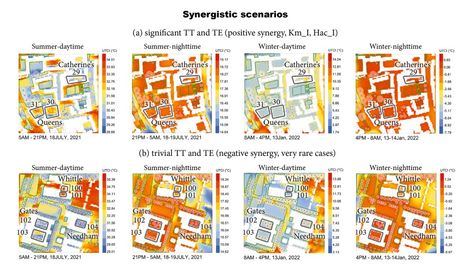Research Round-up: AI comes to town
Science Editors Tom Malloch and Suchir Salhan look back at the last week of research from Cambridge, including teens not getting enough nutrients or sleep, AI in Cambridge and how we can all do our bit for mental health

Carbon emissions from fertilisers could be reduced by 80% in 2050
Cambridge researchers have calculated the carbon footprint for the full life cycle of fertilisers, which are responsible for approximately five percent of total greenhouse gas emissions could be reduced to one-fifth of current levels by 2050.
Co-author Dr André Cabrera Serrenho from Cambridge’s Department of Engineering said: “Incredibly, we don’t actually know how many chemicals we produce globally, where they end up, where and how they accumulate, how many emissions they produce, and how much waste they generate”.
This comes as Varsity reports on the poor performance of the University in achieving its own environmental goals.
The Environmental Cost of Technology
A team from Cambridge, together with colleagues at the Baker Institute in Melbourne, Australia, found that running a genome-wide association study for 1,000 traits would generate 17.3 tonnes of CO2e. That’s equivalent to 346 flights between Paris and London.
In order to address these environmental challenges, Loic Lannelongue (a PhD in health data science at Cambridge’s Department of Public Health and Primary Care) notes: “When you first arrive as a PhD student, you’re like a kid in a candy store – you basically have unlimited computing power at your fingertips. It’s brilliant and it enables great research, so it definitely shouldn’t stop, but the problem is you just think it’s free.” They have been developing a website called Green Algorithms to improve transparency on these hidden environmental costs.
Not enough veg? Blame it on sleep!
A new study from the Department of Psychiatry and Epidemiology Unit here in Cambridge, has found more evidence for the effect that sleep can have on our diet. Using data from the historic ROOTS dataset, researchers looked at whether lack of sleep had an impact on fruit and vegetable intake in teens.
One hour less sleep overnight led to a decrease of around 5% in fruit and veg intake the next day. While a small effect, the study did not look for longer term impacts – it’s possible the reduction could grow more severe if sleep deprivation were to continue.
Whether that’s the case or not, next time your teenage siblings aren’t eating their greens, you can give them some insightful advice: get more sleep!
The effects of masking autistic traits
Researchers from Cambridge’s Autism Research Centre and elsewhere have published a new paper looking into the impact “camouflaging” can have on the mental health of autistic adults.
“Camouflaging”, or “masking” means exactly what you might expect; compensating for neurodivergent characteristics to access social settings and other spaces, at the potential expense of mental health, fatigue and anxiety, as indicated by qualitative surveys.
With up to 79% of adults with autism meeting diagnostic criteria for co-occurring psychiatric conditions, the paper sets out to explore if masking can explain why this number is so high.
Recruiting participants from the Cambridge Autism Research Database and elsewhere, researchers fielded surveys for whether and how masking affected diagnosed and self-identified autistic adults, finding strong negative impacts of masking.
The main factor affecting depth of negative feelings towards and from the behaviour was total time spent masking, increasing fatigue and symptoms of depression.
There is good news from the paper; formal diagnosis, as well as wider awareness and acknowledgement of masking commonly helped diminish the negative feelings associated with the behaviour, consistent with the above and indicating that exercising kindness and compassion may be the most effective approach to helping ease this issue.
AI comes to a courtyard near you
A study from the University’s Department of Architecture, in collaboration with researchers in the Netherlands and California, has set AI to work on 107 of Cambridge’s very own courtyards.

The team set an artificial neural network off on a dataset collected from fieldwork on the sites. The dataset included measurements of courtyard area, temperature, courtyard tree coverage for each of the courtyards, and much more data besides. The neural network used this database to draw up the factors important in regulating the microclimate of a given courtyard. The conclusions agreed with empirical rules of thumb – that vegetation and tree cover were often more important than the surrounding structure, or building alterations in fostering a comfortable microclimate.
Courtyards – of which Cambridge has plenty – provide a happy medium on which to test this new AI technique, coming between overly-simple computer models and entire urban climates. It’s hoped that an extension of the approach could lead to development of tools for urban regeneration plans, helping to reduce the costs – both monetary and temporal – of physical surveying.
The IMF: will its gender strategy work?
A team from Glasgow, Cambridge, Georgetown and Rotterdam has examined the impact of gendered impact economic aid. During times of economic stress, organisations such as the International Monetary Fund (IMF) can provide financial relief to countries, typically under conditions of economic reform – including public sector expenditure reductions.
Numerous studies have confirmed that women often bear more of the brunt for these reforms, including greater risk of job loss, and being more exposed to cutbacks in public services.
With 2022’s introduction of the IMF Gender Strategy, a new attempt to mitigate against this problem, the study looks back at the last two decades of IMF interventions, across 95 countries
They evaluated public sector employment outcomes following mandated reforms, and compared whether the gender difference was reduced if women were more represented in government.
Under an all-male cabinet, women’s share of public employment fell by an average of 0.7%, from 12.6%. When the government included at least one female minister, the proportion actually increased by 0.8% – though only to 12.7% of the workforce overall. Women were also increasingly likely to fear job and income loss with decreasing representation in government, highlighting the differential emotional (as well as economic) stress such policies can bring.
 Comment / Plastic pubs: the problem with Cambridge alehouses 5 January 2026
Comment / Plastic pubs: the problem with Cambridge alehouses 5 January 2026 News / Cambridge businesses concerned infrastructure delays will hurt growth5 January 2026
News / Cambridge businesses concerned infrastructure delays will hurt growth5 January 2026 News / New movement ‘Cambridge is Chopped’ launched to fight against hate crime7 January 2026
News / New movement ‘Cambridge is Chopped’ launched to fight against hate crime7 January 2026 News / AstraZeneca sues for £32 million over faulty construction at Cambridge Campus31 December 2025
News / AstraZeneca sues for £32 million over faulty construction at Cambridge Campus31 December 2025 Interviews / You don’t need to peak at Cambridge, says Robin Harding31 December 2025
Interviews / You don’t need to peak at Cambridge, says Robin Harding31 December 2025










